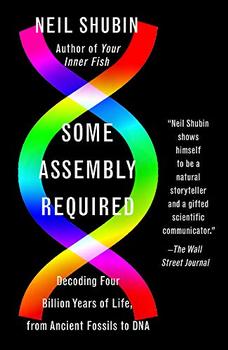Summary | Excerpt | Reviews | Beyond the Book | Readalikes | Genres & Themes | Author Bio
Decoding Four Billion Years of Life, from Ancient Fossils to DNA
by Neil Shubin

Critics' Opinion:
Readers' Opinion:
First Published:
Mar 2020, 288 pages
Paperback:
Aug 2021, 288 pages
 Book Reviewed by:
Book Reviewed by:
Ian Muehlenhaus
Buy This Book
Call them what you will—fish, amphibian, or something in between—these creatures had fins and gills to live in water but also lungs to breathe air. And they weren't just one-offs. In 1860 still another fish with lungs was discovered in Queensland, Australia. This fish also had a very distinctive set of teeth. Shaped like a flat cookie cutter, such teeth were known from the fossil record from a species that was long extinct—an animal named Ceratodus found in rocks over 200 million years old. The implication was clear: lunged, air-breathing fish were global and had been living on Planet Earth for hundreds of millions of years.
An aberrant observation can be a game changer for how we see the world. Fish lungs and swim bladders spawned a generation of scientists interested in exploring the history of life by looking both at fossils and at living creatures. Fossils show what life looked like in the distant past, and living creatures reveal how anatomical structures work, as well as how organs develop from egg to adult. As we'll see, this is a powerful approach.
Linking studies of fossils and embryos was a fruitful area of inquiry for the natural scientists who followed Darwin. Bashford Dean (1867–1928) had an unusual distinction in academic circles—he is the only person ever to hold a curatorship at both the Metropolitan Museum of Art and, directly across Central Park, the American Museum of Natural History. He had two passions in life, fossil fish and battle armor. He founded the armor collection and displays at the Met, and he did the same for the fish collection at the Museum of Natural History. Befitting a person with such interests, he was a quirky individual. He designed his own armor and even took to wearing it on the streets of Manhattan.
When he wasn't donning medieval faulds, Bashford Dean was studying ancient fish. Somewhere locked inside the embryo's transformation from egg to adult, he believed, were answers to the mysteries of history and the mechanism of current fish's descent from ancestral species. Comparing fish embryos with fossils and reviewing the work in anatomy labs at the time, Dean saw that lungs and swim bladders look essentially the same during development. Both organs bud from the gut tube and both form air sacs. The major difference is that swim bladders develop on the top of the tube, near the spine, while lungs bud from the bottom, or belly side. Using these insights, Dean argued that swim bladders and lungs were different versions of the same organ, formed by the same developmental process. Indeed, some kind of air sac is present in virtually all fish but sharks. Like many ideas in science, Dean's comparison has a long history. Its antecedents can be seen in the work of nineteenth-century German anatomists.
But what do air sacs say about Mivart's critique and Darwin's response?
A surprising number of fish can breathe air for extended periods of time. The six-inch-long mudskipper can walk and live on the mud for over twenty-four hours. The aptly named climbing perch can wiggle from pond to pond as needed, sometimes even climbing branches and stepping over twigs in the process. But that perch is only a single species. Hundreds of species can gulp air when the concentration of oxygen in the water they inhabit declines. How do these fish do it?
Some, like the mudskipper, absorb oxygen through their skin. Others have a special gas-exchange organ above their gills. Some catfish and other species absorb oxygen through their guts, gulping air like food, only to use it to breathe. And a number of fish have paired lungs that look like our own. Lungfish live in water and breathe with their gills most of the time, but when the oxygen content of their stream is not sufficient to support their metabolism, they will push to the surface and gulp air into their lungs. Air breathing is not some crazy exception in an oddball fish—it is the common state of affairs.
Excerpted from Some Assembly Required by Neil Shubin. Copyright © 2020 by Neil Shubin. All rights reserved. No part of this excerpt may be reproduced or reprinted without permission in writing from the publisher.





The House on Biscayne Bay
by Chanel Cleeton
As death stalks a gothic mansion in Miami, the lives of two women intertwine as the past and present collide.

The Flower Sisters
by Michelle Collins Anderson
From the new Fannie Flagg of the Ozarks, a richly-woven story of family, forgiveness, and reinvention.

The Funeral Cryer by Wenyan Lu
Debut novelist Wenyan Lu brings us this witty yet profound story about one woman's midlife reawakening in contemporary rural China.
Your guide toexceptional books
BookBrowse seeks out and recommends the best in contemporary fiction and nonfiction—books that not only engage and entertain but also deepen our understanding of ourselves and the world around us.